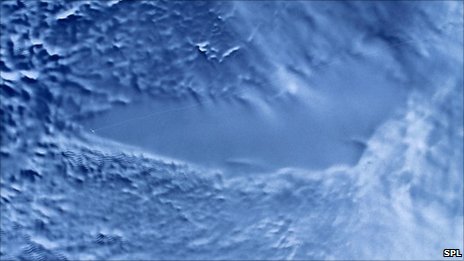Lake Vostok is a preserved jewel of Antarctica.
- Lake Vostok is a very large water lake that exists underneath an ice glacier in Antarctica, and despite being submerged in darkness, it contains numerous micro-organisms, some of which are not uncommon in other water bodies.
- Lake Vostok is the largest known underground lake in Antarctica, covering up to 14,000 square kilometres (5405 square miles) in area and reaching estimated depths of 510 to 900 metres (1700 to 3000 feet).
- Andrey Kapitsa, Russian geographer, accurately predicted the existence and location of Lake Vostok in the early 1960s.
- ‘Lake Vostok’ was named after the Russian research station, Vostok Station, that is situated directly above the lake.
- The Russians were not only the discoverers of Lake Vostok, but also the earliest to theorise the existence of underground lakes in Antarctica, first led by Peter Kropotkin, scientist, in the 1800s.
 Satellite Image of Lake Vostok
Satellite Image of Lake Vostok
Image courtesy of NASA
- Despite evidence of Lake Vostok’s existence, the lake was never actually confirmed until 1993, and it was not until early 2012 when the lake’s surface was first penetrated.
- It is possible that the water of Lake Vostok is gradually cycled throughout thousands of years, as water is lost while the above glacier is mobile, and is in turn replaced by ice melting.
- Despite the freezing temperatures of Antarctica, and even though the water temperature of Lake Vostok is approximately minus three degrees Celsius (26.6 degrees Fahrenheit), the lake remains unfrozen due to the enormous pressure it sits under.
- Tides are evident in Lake Vostok, and therefore are dependent on planetary positioning, while the lake’s surface can reach up to 1.2 centimetres (0.47 inches) higher than normal as a result.
- One of the longest ice cores, drilled from more than 3,600 metres (11,811 feet) deep, has been extracted during the studies of Lake Vostok, despite the lake being only 500 metres (1640 feet) below sea level, as the ice above is up to 4 kilometres (2.5 miles) thick.
Bibliography:
Lake Vostok, 2015, Wikipedia, http://en.wikipedia.org/wiki/Lake_Vostok
Lake Vostok mysteries: Biologists find over 3,500 life forms in isolated Antarctic basin, 2013, RT, http://rt.com/news/lake-vostok-bacteria-dna-745/
Maxwell B, Broughton D, Rogers J & Weymouth W, Ethics of Subglacial lake Exploration in Antarctica, 2012, University of Canterbury, http://www.anta.canterbury.ac.nz/documents/PCAS_14/SyndicateReports/Subglacial%20Lake%20Exploration%20Syndicate%20Report.pdf







